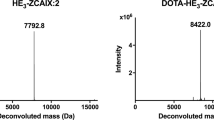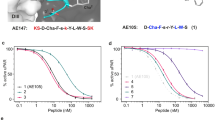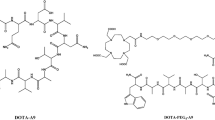Abstract
Extracellular matrix metalloproteinase inducer CD147 is a glycoprotein on the cell surface. There is minimal expression of CD147 in normal epithelial and fetal tissues, but it is highly expressed in a number of aggressive tumors. CD147 has been implicated in pan-cancer immunity and progression. With the development of CD147-targeting therapeutic strategy, accurate detection of CD147 expression in tumors and its changes during the therapy is necessary. In this study we constructed a novel radiotracer by labeling the anti-CD147 mAb with radionuclide 124/125I (124/125I-anti-CD147) for noninvasive detection of CD147 expression in pan-cancers, and characterized its physicochemical properties, affinity, metabolic characteristics, biodistribution and immunoPET imaging with 124I-IgG and 18F-FDG as controls. By examining the expression of CD147 in cancer cell lines, we found high CD147 expression in colon cancer cells LS174T, FADU human pharyngeal squamous cancer cells and 22RV1 human prostate cancer cells, and low expression of CD147 in human pancreatic cancer cells ASPC1 and human gastric cancer cells BGC823. 124/125I-anti-CD147 was prepared using N-bromine succinimide (NBS) as oxidant and purified by PD-10 column. Its radiochemical purity (RCP) was over 99% and maintained over 85% in saline or 5% human serum albumin (HSA) for more than 7 d; the RCP of 125I-anti-CD147 in blood was over 90% at 3 h post injection (p.i.) in healthy mice. The Kd value of 125I-anti-CD147 to CD147 protein was 6.344 nM, while that of 125I-IgG was over 100 nM. 125I-anti-CD147 showed much greater uptake in CD147 high-expression cancer cells compared to CD147 low-expression cancer cells. After intravenous injection in healthy mice, 125I-anti-CD147 showed high initial uptake in blood pool and liver, the uptake was decreased with time. The biological half-life of distribution and clearance phases in healthy mice were 0.63 h and 19.60 h, respectively. The effective dose of 124I-anti-CD147 was estimated as 0.104 mSv/MBq. We conducted immunoPET imaging in tumor-bearing mice, and demonstrated a significantly higher tumor-to-muscle ratio of 124I-anti-CD147 compared to that of 124I-IgG and 18F-FDG in CD147 (+) tumors. The expression levels of CD147 in cells and tumors were positively correlated with the maximum standardized uptake value (SUVmax) (P < 0.01). In conclusion, 124/125I-anti-CD147 displays high affinity to CD147, and represents potential for the imaging of CD147-positive tumors. The development of 124I-anti-CD147 may provide new insights into the regulation of tumor microenvironment and formulation of precision diagnosis and treatment programs for tumors.

This is a preview of subscription content, access via your institution
Access options
Subscribe to this journal
Receive 12 print issues and online access
$259.00 per year
only $21.58 per issue
Buy this article
- Purchase on Springer Link
- Instant access to full article PDF
Prices may be subject to local taxes which are calculated during checkout






Similar content being viewed by others
References
Stewart BWC. World cancer report 2020 [M]. mprimerie Faurite. France; World Health Organization. 2020.
Sung H, Ferlay J, Siegel RL, Laversanne M, Soerjomataram I, Jemal A, et al. Global Cancer Statistics 2020: GLOBOCAN Estimates of incidence and mortality worldwide for 36 cancers in 185 countries. CA Cancer J Clin. 2021;71:209–49.
Rahib L, Wehner MR, Matrisian LM, Nead KT. Estimated projection of US cancer incidence and death to 2040. JAMA Netw Open. 2021;4:e214708.
Landras A, Reger de Moura C, Jouenne F, Lebbe C, Menashi S, Mourah S. CD147 is a promising target of tumor progression and a prognostic biomarker. Cancers. 2019;11:1803–19.
Gabison EE, Huet E, Baudouin C, Menashi S. Direct epithelial-stromal interaction in corneal wound healing: role of EMMPRIN/CD147 in MMPs induction and beyond. Prog Retin Eye Res. 2009;28:19–33.
Li Y, Xu J, Chen L, Zhong WD, Zhang Z, Mi L, et al. HAb18G (CD147), a cancer-associated biomarker and its role in cancer detection. Histopathology. 2009;54:677–87.
Peng L, Zhu H, Wang J, Sui H, Zhang H, Jin C, et al. MiR-492 is functionally involved in oxaliplatin resistance in colon cancer cells LS174T via its regulating the expression of CD147. Mol Cell Biochem. 2015;405:73–79.
Fang F, Li Q, Wu M, Nie C, Xu H, Wang L. CD147 promotes epithelial-mesenchymal transition of prostate cancer cells via the Wnt/β-catenin pathway. Exp Ther Med. 2020;20:3154–60.
Zhang W, Liu H, Jiang J, Yang Y, Wang W, Jia Z. Expression of CD147 after neoadjuvant chemotherapy and its relationship with prognosis in patients with triple negative breast cancer. Am J Transl Res. 2022;14:2952–61.
Suzuki S, Toyoma S, Kawasaki Y, Nanjo H, Yamada T. CD147 promotes invasion and MMP-9 expression through MEK signaling and predicts poor prognosis in hypopharyngeal squamous cell carcinoma. Adv Clin Exp Med. 2021;30:41–48.
Wang SJ, Chao D, Wei W, Nan G, Li JY, Liu FL, et al. CD147 promotes collective invasion through cathepsin B in hepatocellular carcinoma. J Exp Clin Cancer Res. 2020;39:145–62.
Koch C, Staffler G, Hüttinger R, Hilgert I, Prager E, Cerný J, et al. T cell activation-associated epitopes of CD147 in regulation of the T cell response, and their definition by antibody affinity and antigen density. Int Immunol. 1999;11:777–86.
Weidle UH, Scheuer W, Eggle D, Klostermann S, Stockinger H. Cancer-related issues of CD147. Cancer Genom Proteom. 2010;7:157–69.
Zhang J, Wang Z, Zhang X, Dai Z, Zhi-Peng W, Yu J, et al. Large-scale single-cell and bulk sequencing analyses reveal the prognostic value and immune aspects of CD147 in pan-cancer. Front Immunol. 2022;13:810471.
Tseng HC, Xiong W, Badeti S, Yang Y, Ma M, Liu T, et al. Efficacy of anti-CD147 chimeric antigen receptors targeting hepatocellular carcinoma. Nat Commun. 2020;11:4810–24.
Chen Y, Xu J, Wu X, Yao H, Yan Z, Guo T, et al. CD147 regulates antitumor CD8+ T-cell responses to facilitate tumor-immune escape. Cell Mol Immunol. 2021;18:1995–2009.
Xu J, Shen ZY, Chen XG, Zhang Q, Bian HJ, Zhu P, et al. A randomized controlled trial of Licartin for preventing hepatoma recurrence after liver transplantation. Hepatology. 2007;45:269–76.
Sugyo A, Tsuji AB, Sudo H, Nagatsu K, Koizumi M, Ukai Y, et al. Evaluation of 89Zr-labeled human anti-CD147 monoclonal antibody as a positron emission tomography probe in a mouse model of pancreatic cancer. PLoS One. 2013;8:e61230.
Sharma P, Singh SS, Gayana S. Fibroblast activation protein inhibitor PET/CT: A promising molecular imaging tool. Clin Nucl Med. 2021;46:e141–e50.
Fonti R, Conson M, Del Vecchio S. PET/CT in radiation oncology. Semin Oncol. 2019;46:202–9.
He K, Zeng S, Qian L. Recent progress in the molecular imaging of therapeutic monoclonal antibodies. J Pharm Anal. 2020;10:397–413.
Wang X, An Z, Luo W, Xia N, Zhao Q. Molecular and functional analysis of monoclonal antibodies in support of biologics development. Protein Cell. 2018;9:74–85.
Chen H, Nan G, Wei D, Zhai RY, Huang M, Yang WW, et al. Hepatic artery injection of 131I-metuximab combined with transcatheter arterial chemoembolization for unresectable hepatocellular carcinoma: a prospective nonrandomized, multicenter clinical trial. J Nucl Med. 2022;63:556–59.
Li J, Xing J, Yang Y, Liu J, Wang W, Xia Y, et al. Adjuvant 131I-metuximab for hepatocellular carcinoma after liver resection: a randomised, controlled, multicentre, open-label, phase 2 trial. Lancet Gastroenterol Hepatol. 2020;5:548–60.
Feng W, Liu T, Li T, Guo X. Production, quality control of next-generation PET radioisotope iodine-124 and its thyroid imaging. J Radioanal Nucl Ch. 2018;318:1999–2006.
Yu J, Kane S, Wu J, Benedettini E, Li D, Reeves C, et al. Mutation-specific antibodies for the detection of EGFR mutations in non-small-cell lung cancer. Clin Cancer Res. 2009;15:3023–28.
Hughes DJ, Subesinghe M, Taylor B, Bille A, Spicer J, Papa S, et al. 18F FDG PET/CT and novel molecular imaging for directing immunotherapy in cancer. Radiology. 2022;304:246–64.
Wu J, Mayer AT, Li R. Integrated imaging and molecular analysis to decipher tumor microenvironment in the era of immunotherapy. Semin Cancer Biol. 2022;84:310–28.
Mayer AT, Gambhir SS. The immunoimaging toolbox. J Nucl Med. 2018;59:1174–82.
Salvatore V, Teti G, Focaroli S, Mazzotti MC, Mazzotti A, Falconi M. The tumor microenvironment promotes cancer progression and cell migration. Oncotarget. 2017;8:9608–16.
Quail DF, Joyce JA. Microenvironmental regulation of tumor progression and metastasis. Nat Med. 2013;19:1423–37.
Palumbo A Jr., Da Costa Nde O, Bonamino MH, Pinto LF, Nasciutti LE. Genetic instability in the tumor microenvironment: a new look at an old neighbor. Mol Cancer. 2015;14:145–59.
Hahn JN, Kaushik DK, Yong VW. The role of EMMPRIN in T cell biology and immunological diseases. J Leukoc Biol. 2015;98:33–48.
Chen ZN, Mi L, Xu J, Song F, Zhang Q, Zhang Z, et al. Targeting radioimmunotherapy of hepatocellular carcinoma with iodine 131I-metuximab injection: clinical phase I/II trials. Int J Radiat Oncol Biol Phys. 2006;65:435–44.
Huang H, Zhu H, Xie Q, Tian X, Yang X, Feng F, et al. Evaluation of 124I-JS001 for hPD1 immuno-PET imaging using sarcoma cell homografts in humanized mice. Acta Pharm Sin B. 2020;10:1321–30.
Crimì F, Valeggia S, Baffoni L, Stramare R, Lacognata C, Spolverato G, et al. [18F]FDG PET/MRI in rectal cancer. Ann Nucl Med. 2021;35:281–90.
Kaji T, Osanai K, Nakata T, Tamaki N. Dynamic whole-body 18F-FDG PET for minimizing patient motion artifact. Clin Nucl Med. 2020;45:880–2.
Norikane T, Yamamoto Y, Mitamura K, Tani R, Nishiyama Y. False-positive 18F-FDG and 18F-fluorothymidine uptake in a patient with round atelectasis. Clin Nucl Med. 2020;45:e158–e59.
Li S, Zheng Q, Ma Y, Wang Y, Feng Y, Zhao B, et al. Implications of false negative and false positive diagnosis in lymph node staging of NSCLC by means of 18F-FDG PET/CT. PLoS One. 2013;8:e78552.
Mochizuki T, Tsukamoto E, Kuge Y, Kanegae K, Zhao S, Hikosaka K, et al. FDG uptake and glucose transporter subtype expressions in experimental tumor and inflammation models. J Nucl Med. 2001;42:1551–55.
Rakhshandehroo T, Smith BR, Glockner HJ, Rashidian M, Pandit-Taskar N. Molecular immune targeted imaging of tumor microenvironment. Nanotheranostics. 2022;6:286–305.
England CG, Jiang D, Hernandez R, Sun H, Valdovinos HF, Ehlerding EB, et al. ImmunoPET imaging of CD146 in murine models of intrapulmonary metastasis of non-small cell lung cancer. Mol Pharm. 2017;14:3239–47.
Zanelli GD, Fowler JF. The measurement of tumor blood perfusion and blood volume by means of radioactive tracers. Br J Radiol. 1974;47:740.
Hanin FX, Pauwels S, Bol A, Breeman W, de Jong M, Jamar F. Tumor uptake of 68Ga-DOTA-Tyr3-octreotate: animal PET studies of tumor flow and acute somatostatin receptor modulation in the CA20948 rat model. Nucl Med Biol. 2010;37:157–65.
Carlin S, Zhang H, Reese M, Ramos NN, Chen Q, Ricketts SA. A comparison of the imaging characteristics and microregional distribution of 4 hypoxia PET tracers. J Nucl Med. 2014;55:515–21.
Oosting SF, Brouwers AH, van Es SC, Nagengast WB, Oude Munnink TH, Lub-de Hooge MN, et al. 89Zr-bevacizumab PET visualizes heterogeneous tracer accumulation in tumor lesions of renal cell carcinoma patients and differential effects of antiangiogenic treatment. J Nucl Med. 2015;56:63–9.
Acknowledgements
This work was supported by the National Natural Science Foundation of China (No. 82102092, 82171973 and 82171980), Beijing Municipal Hospital Management Center’s "Young Seedlings" Project (QML20231111), Capital’s Funds for Health Improvement and Research (No. 2022-2Z-2154 and 2022-2Z-2155), National Science and Technology Major Project (No. 2022YFC2406901), Beijing Hospitals Authority Dengfeng Project (DFL20191102), and Guizhou Provincial Science and Technology Department Basic Project Fund (ZK [2021]471).
Author information
Authors and Affiliations
Contributions
A collaborative effort between ZY and HZ led to the design of the project and funding for its implementation. XKM wrote the manuscript, conducted animal studies, imaging, in vitro studies and data analysis. TLL conducted antibody radiolabelings and in vivo experiments. YNR, YY and XPM performed the pharmacokinetics and biodistribution of the probes. FW, XGH and JD produced and purified radionuclide 124I. XKM, TLL and HFH conducted the literature review and participated in the revision of the manuscript. ZY, HZ and TLL contributed to the study design and conceptualization, supervision, and manuscript revision.
Corresponding authors
Ethics declarations
Competing interests
The authors declare no competing interests.
Supplementary information
Rights and permissions
Springer Nature or its licensor (e.g. a society or other partner) holds exclusive rights to this article under a publishing agreement with the author(s) or other rightsholder(s); author self-archiving of the accepted manuscript version of this article is solely governed by the terms of such publishing agreement and applicable law.
About this article
Cite this article
Ma, Xk., Liu, Tl., Ren, Yn. et al. 124I-labeled anti-CD147 antibody for noninvasive detection of CD147-positive pan-cancers: construction and preclinical studies. Acta Pharmacol Sin 45, 436–448 (2024). https://doi.org/10.1038/s41401-023-01162-y
Received:
Accepted:
Published:
Issue Date:
DOI: https://doi.org/10.1038/s41401-023-01162-y



